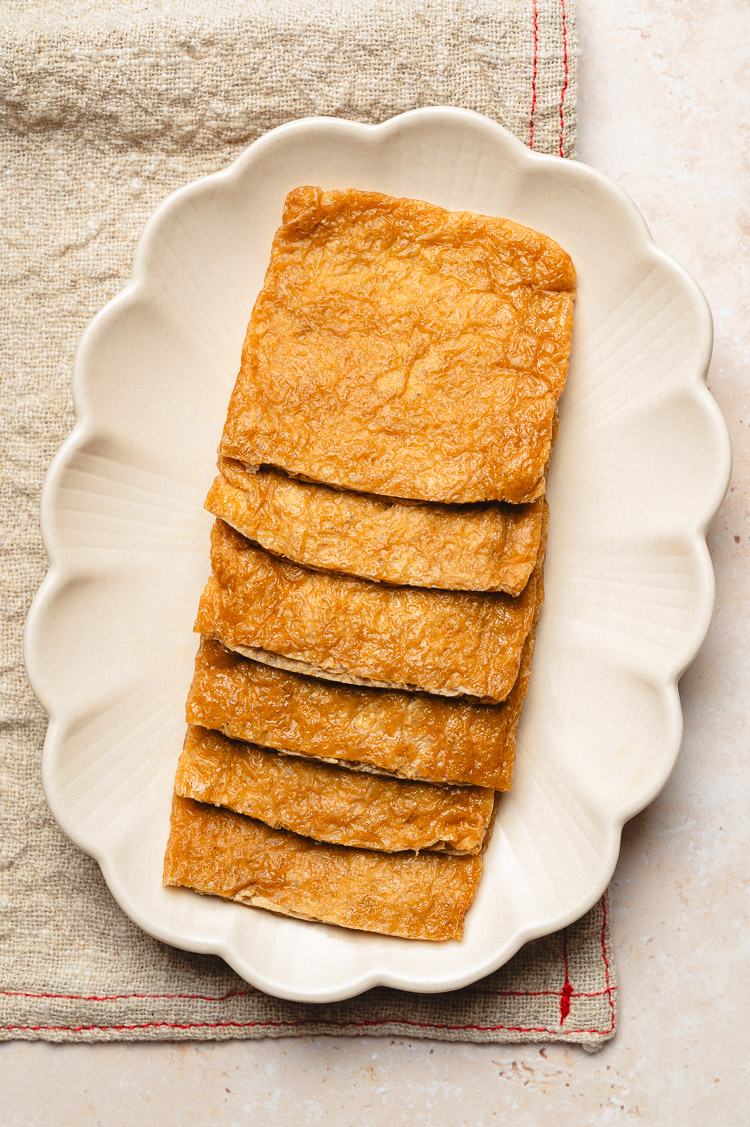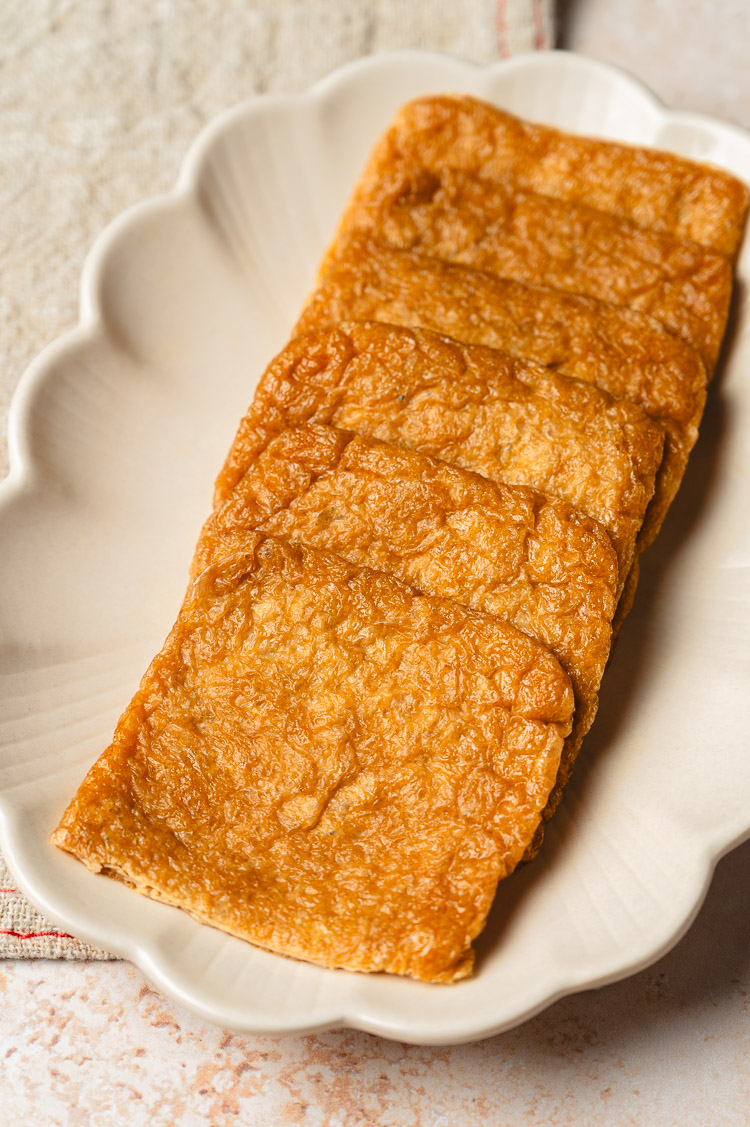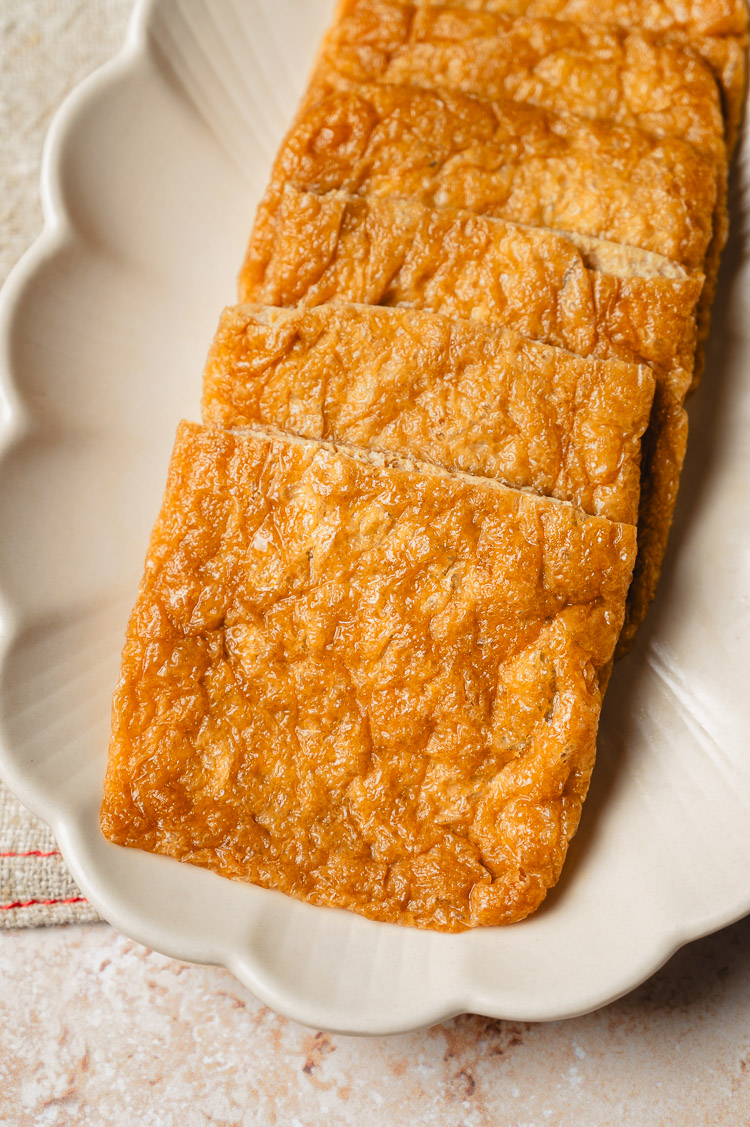Homemade Inari Age いなり揚げ
Learn how to make inari age, Japanese seasoned tofu pouches used in inari sushi and kitsune udon. It’s easy to make with just 5 ingredients.

What is Inari Age いなり揚げ?
Inari age are Japanese fried tofu pouches (aburaage) seasoned in a sweet and savory sauce. They can be used in a variety of dishes, but inari sushi is most widely known. While you can buy pre-seasoned inari age at Japanese stores, they can be quite sweet and salty. I started making my own at home, and it’s actually really easy and so tasty! It doesn’t take long at all, and you can make large batches and freeze them for later.

Key Ingredients
- Aburaage ⟶ These are deep fried tofu pouches that can be opened and stuffed (carefully, they do break). I use them stuffed in my spicy mochi kinchaku stew!
- Kombu Dashi ⟶ Use kombu dashi powder* for convenience, or make your own kombu dashi by soaking 3 grams of dried kombu in 200ml of water overnight in the fridge or at room temperature for 2-3 hours.
- Soy Sauce, Mirin, and Sugar ⟶ For sweet and savory flavor that makes the inari so irresistible! I like to use low sodium soy sauce*.

Tips for Success
Boil aburaage before seasoning ⟶ Boiling helps remove the factory oil coating the aburaage. You can also pour boiling water over them, but I think boiling removes more oil.
Roll out aburaage ⟶ Gently roll out the aburaage with a chopstick or rolling pin. This makes it easier to open them up later for stuffing.
Use otoshibuta when simmering ⟶ Otoshibuta (or drop lid) is used very often in Japanese cooking. It sits directly on top of the food in the pot, preventing them from moving around too much and promoting more even cooking. If you don’t have an otoshibuta, you can use a piece of parchment paper or foil with some small holes poked in the top.
Stop cooking when there is still a little bit of liquid left ⟶ The aburaage will soak up the liquid as it sits. It will be extra flavorful if you let it sit overnight in the fridge.

Inari Age FAQ
Is inari age vegan/plant-based?
This recipe is plant-based, however they can contain fish at stores/restaurants due to using a fish-based dashi. So be sure to check the ingredients if this is a concern for you.
Where do I buy aburaage?
You can buy aburaage at Japanese supermarkets or some Korean markets (I’ve seen them at H Mart). They are usually frozen and come in rectangular or square shapes. I used rectangular ones for this recipe.
Can I make it without dashi?
Dashi adds savory, umami flavor. You can just use water if you don’t have dashi, but it won’t be as flavorful. Or use water and 1/4 tsp MSG.

How to Use Inari Age
- Inari Sushi – probably the most common use for inari age.
- In udon and soba (kitsune udon/kitsune soba).
- Try it in place of aburaage in my takikomi gohan, spicy mochi kinchaku stew, or miso kenchinjiru.
- Added to salads or stir fries.
If you make this recipe, don’t forget to leave a comment/rating down below and tag me in your photos on instagram @ellielikes.cooking. I love seeing all of your tasty recreations!
Homemade Inari Age いなり揚げ

Ingredients
- 6 rectangular aburaage
- 2 tbsp sugar
- 2 tbsp soy sauce
- 2 tbsp mirin
- 200 ml kombu dashi**1
Instructions
- Boil aburaage: Bring a pot of water to a boil. Add aburaage and boil for 1 minute on each side, pressing them down into the water. Drain and rinse the aburaage. Gently press down on them to remove excess water (they tear easily so be careful).
- Roll and cut aburaage: Place aburaage on a cutting board. Use a chopstick to roll out each aburaage. This helps separate the layers, making them easier to open and stuff later. Cut aburaage in half so you have 12 square pieces.
- Add to saucepan with seasonings: Mix sugar, soy sauce, mirin, water, and dashi powder in a saucepan. Add aburaage pieces on top overlapping. Place an otoshibuta (drop lid) on the aburaage (see notes if you don't have otoshibuta**2).
- Simmer: Turn heat on medium low and simmer the aburaage until most of the liquid is gone (about 10 minutes). You can flip the aburaage halfway for more even seasoning, but it's not completely necessary.
- Cool: Remove from heat when there is still a little bit of liquid left in the pan. Set aside to cool uncovered.
- Store: Transfer inari age and any remaining cooking liquid to an airtight container. Store in the fridge for up to 3 days. To freeze, drain excess liquid then wrap individually or layer with foil or parchment paper so they don't stick. They will last in the freezer for up to a month.
Notes

*Disclosure: This page may contain affiliate links. As an Amazon Associate I earn from qualifying purchases, but the price remains the same to you. Thank you for supporting Ellie Likes Cooking!
Save for later!







